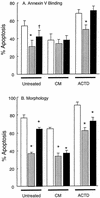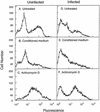Anaplasma phagocytophilum reduces neutrophil apoptosis in vivo
- PMID: 12654818
- PMCID: PMC152089
- DOI: 10.1128/IAI.71.4.1995-2001.2003
Anaplasma phagocytophilum reduces neutrophil apoptosis in vivo
Abstract
Ovine neutrophils spontaneously underwent apoptosis during culture in vitro, as assessed by morphological changes and exposure of annexin V binding sites on their cell surfaces. The addition of conditioned medium from concanavalin A-treated ovine peripheral blood mononuclear cells (PBMC) could partially protect against this progression into apoptosis, but dexamethasone and sodium butyrate could not. Actinomycin D accelerated the rate at which ovine neutrophils underwent apoptosis. Neutrophils isolated from sheep experimentally infected with Anaplasma phagocytophilum showed significantly delayed apoptosis during culture ex vivo, and the addition of conditioned medium from PBMC to these cells could not delay apoptosis above the protective effects observed after in vivo infection. The ability of neutrophils from A. phagocytophilum-infected sheep to activate a respiratory burst was increased compared to the activity measured in neutrophils from uninfected sheep, but chemotaxis was decreased in neutrophils from infected sheep. These data are the first demonstration that in vivo infection with A. phagocytophilum results in changes in rates of apoptosis of infected immune cells. This may help explain how these bacteria replicate in these normally short-lived cells.
Figures





Similar articles
-
Purification of ovine neutrophils and eosinophils: Anaplasma phagocytophilum affects neutrophil density.J Comp Pathol. 2003 May;128(4):277-82. doi: 10.1053/jcpa.2002.0633. J Comp Pathol. 2003. PMID: 12834611
-
Anaplasma phagocytophilum up-regulates some anti-apoptotic genes in neutrophils and pro-inflammatory genes in mononuclear cells of sheep.J Comp Pathol. 2014 May;150(4):351-6. doi: 10.1016/j.jcpa.2014.01.005. Epub 2014 Jan 24. J Comp Pathol. 2014. PMID: 24602324
-
Neuropathological changes in ovine fetuse caused by tickborne fever.Vet Rec. 2004 Dec 18-25;155(25):805-6. Vet Rec. 2004. PMID: 15651549 No abstract available.
-
Mechanisms of evasion of neutrophil killing by Anaplasma phagocytophilum.Curr Opin Hematol. 2006 Jan;13(1):28-33. doi: 10.1097/01.moh.0000190109.00532.56. Curr Opin Hematol. 2006. PMID: 16319684 Review.
-
Invasion and survival strategies of Anaplasma phagocytophilum.Cell Microbiol. 2003 Nov;5(11):743-54. doi: 10.1046/j.1462-5822.2003.00323.x. Cell Microbiol. 2003. PMID: 14531890 Review.
Cited by
-
Bacterial pathogens modulate an apoptosis differentiation program in human neutrophils.Proc Natl Acad Sci U S A. 2003 Sep 16;100(19):10948-53. doi: 10.1073/pnas.1833375100. Epub 2003 Sep 5. Proc Natl Acad Sci U S A. 2003. PMID: 12960399 Free PMC article.
-
Anaplasma phagocytophilum Activates NF-κB Signaling via Redundant Pathways.Front Public Health. 2020 Oct 30;8:558283. doi: 10.3389/fpubh.2020.558283. eCollection 2020. Front Public Health. 2020. PMID: 33194960 Free PMC article.
-
Peculiarities of cell death mechanisms in neutrophils.Cell Death Differ. 2011 Sep;18(9):1457-69. doi: 10.1038/cdd.2011.75. Epub 2011 Jun 3. Cell Death Differ. 2011. PMID: 21637292 Free PMC article. Review.
-
Neutrophil Isolation and Analysis to Determine their Role in Lymphoma Cell Sensitivity to Therapeutic Agents.J Vis Exp. 2016 Mar 25;(109):e53846. doi: 10.3791/53846. J Vis Exp. 2016. PMID: 27078837 Free PMC article.
-
Anaplasma phagocytophilum and Ehrlichia chaffeensis: subversive manipulators of host cells.Nat Rev Microbiol. 2010 May;8(5):328-39. doi: 10.1038/nrmicro2318. Epub 2010 Apr 7. Nat Rev Microbiol. 2010. PMID: 20372158 Review.
References
-
- Aga, E., D. M. Katschinski, G. Van Zandbergen, H. Laufs, B. Hansen, K. Muller, W. Solbach, and T. Laskay. 2002. Inhibition of the spontaneous apoptosis of neutrophil granulocytes by the intracellular parasite Leishmania major. J. Immunol. 169:898-905. - PubMed
-
- Akgul, C., D. A. Moulding, and S. W. Edwards. 2001. Molecular control of neutrophil apoptosis. FEBS Lett. 487:318-322. - PubMed
-
- Bakken, J. S., J. S. Dumler, S. M. Chen, M. R. Eckman, L. L. Van Etta, and D. H. Walker. 1994. Human granulocytic ehrlichiosis in the upper midwest United States: a new emerging species? JAMA 272:212-218. - PubMed
-
- Banerjee, R., J. Anguita, D. Roos, and E. Fikrig. 2000. Cutting edge: infection by the agent of human granulocytic ehrlichiosis prevents the respiratory burst by downregulating gp91phox1. J. Immunol. 164:3946-3949. - PubMed
-
- Bedner, E., P. Burfeind, T.-C Hseih, J. M. Wu, M. E. Aguero-Rosenfeld, M. R. Melamed, H. W. Horowitz, G. P. Wormser, and Z. Darzynkiewicz. 1998. Cell cycle effects and induction of apoptosis caused by infection of HL-60 cells with human granulocytic ehrlichiosis pathogen measured by flow and laser scanning cytometry. Cytometry 33:47-55. - PubMed
Publication types
MeSH terms
Substances
Grants and funding
LinkOut - more resources
Full Text Sources

